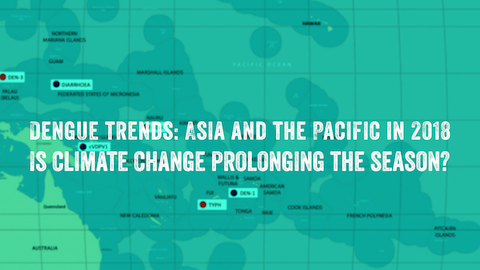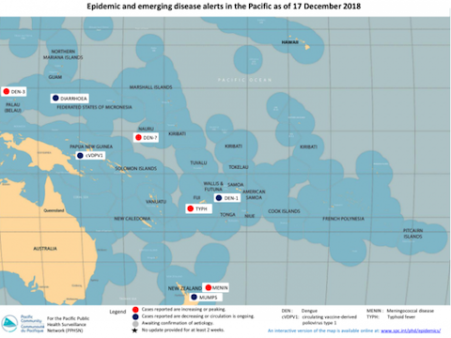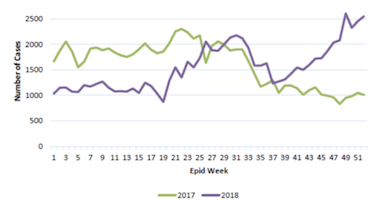- by Alison
Dengue season across Asia and the Pacific Islands. Is climate change prolonging its length?

“Dengue season” is a relative term used by many health officials around the globe. But in many countries where the disease is endemic, dengue season is getting longer, and more intense.
Last year, countries across the world felt the effects of our world’s changing climate: soaring temperature set records across the globe, terrible flooding hit parts of India and a super typhoon caused devastation in the Philippines. The unusual weather brought dengue outbreaks to many Asia Pacific nations, while novel technologies helped others to fight back. Let’s explore the dengue highs and lows experienced by Asia and the Pacific Islands in 2018.

Image via ReliefWeb
Asia’s dengue lows indicate cases are on the rise
Cases of dengue in Thailand in 2018 were up compared with 2017 with official sources reporting a total of 54,482 cases and eight deaths across 77 provinces. Other reports put case numbers over 80,000 and fatalities above 100.
2018 was being called the deadliest year for dengue fever in Bangladesh with 17 deaths by late November and nearly 10,000 dengue cases as of early December. The spike of 3,087 cases reported in September, towards the end of Bangladesh’s monsoon and peak dengue season, was more than double previous years.
The Philippines recorded a 33% rise in dengue cases compared with 2017, with 179,540 cases reported nationally from the beginning of the year through mid-November. Close to a thousand dengue deaths had been recorded by mid-November. The flooding following typhoons contributed to the increase in dengue cases.
Singapore is expecting a surge in dengue cases in 2019 thanks to the 40% increase in the Aedes aegypti population seen in December compared with December 2017. The National Environment Agency (NEA) reported the total number of dengue cases in 2018 as 3,285, a 20% increase on 2017 but lower than in earlier outbreak years.
Cambodia reported a 50% rise in dengue cases and deaths in the first 11 months of 2018 compared with 2017, with 15,233 cases and 16 deaths. The dengue epidemic period peaks from May to October in Cambodia.
Dengue cases began rising in Malaysia mid-September. A total of 5,003 dengue cases including twelve deaths were reported in the last two weeks of 2018, bringing the annual total to 80,615 and 147 deaths, as of 29 December. This contrasts with the downward trend seen from mid-September in 2017.

Dengue cases reported weekly in Malaysia in 2017 and 2018 via W.H.O.
The island of Flores in Indonesia saw a sharp increase in dengue cases from 161 in 2017 to 539 in 2018, with 441 of the cases reported between September and December. Indonesia is home to one of the many Wolbachia programs in Asia to curb dengue outbreaks. The World Mosquito Programme began releases of Wolbachia mosquitoes on the island of Java in small trials in 2011 and is currently in the midst of a large-scale efficacy study to evaluate their impact. In 2019, Indonesia has already seen over 100 dengue deaths in January alone.
The WHO country office is supporting the response to the current outbreak of dengue in Pakistan. As of early January 2019, there have been 16,580 confirmed cases and 257 deaths reported in capital Lahore and nearly 5,000 cases and 60 deaths reported from the rest of the country.
Elsewhere, Oman recorded 67 dengue cases towards the end of 2018, 30 of them imported. France’s Réunion Island’s dengue epidemic had reached 6,712 cases and three deaths by late December.
Asia’s dengue highs: The fight shows its muscle
Official statistics show a worsening dengue situation in India. As of late November, there had been 89,974 cases and 144 deaths across the country. Numbers for the year are most likely going to be down compared with 188,401 cases and 325 deaths in 2017. The WMP is currently undertaking laboratory studies Wolbachia-infected mosquitoes in India.
Sri Lanka saw a substantial decrease in dengue cases in 2018 with 51,271 cases compared with 186,101 cases in 2017, which was one of the country’s worst-ever outbreaks of the disease in recent years. There were also 56 dengue fatalities reported in 2018 Early in 2018, the National Dengue Control Unit launched special programmes to eradicate dengue breeding grounds in several districts of the island country
From March until June last year, WMP carried out its first releases of Wolbachia mosquitoes on mainland Vietnam. Elsewhere around Vietnam, dengue has been taking its toll. Ho Chi Minh City saw a 125% increase in dengue cases in October compared to a year earlier with the city’s hospitals admitting 4,390 people with the disease that month. Late in September Hanoi reported a sharp drop in dengue cases (down 96.8%) compared to the first nine months of 2017.
Australia reported 824 dengue cases in 2018, which was down on previous years. For instance, Queensland reported 212 confirmed dengue cases in 2018 compared with 292 in 2017 and 445 in 2016.
Dengue in the Pacific islands in 2018
Surrounding dengue in the Asia Pacific region, New Caledonia declared dengue outbreaks in February and again in December with nearly 2,000 cases and two deaths by late December. The French territory of the Wallis and Futuna Islands reported a total of 225 dengue cases and one death between September 2017 and early January 2019; Wallis has recently raised its dengue alert level. In December, Palau declared a dengue outbreak following the first ever laboratory confirmation of two
Cases.
In better news, French Polynesia raised a dengue alert in June after two cases were confirmed, then lifted it in August. Fiji dengue case numbers began falling towards the end of May, with 3,437 cases and four deaths at that point. And an early 2018 dengue outbreak in Vanuatu had weakened by late March after 329 suspected and 52 confirmed cases.
With funding and support from the Australian Government’s InnovationXchange, the WMP announced in August release of Wolbachia mosquitoes in the Pacific in Kiribati, Fiji, and Vanuatu.
Do you live or work in the Asia Pacific region? We’d like to know what changed during dengue season in your community during 2018. Share your story with our editors.
—
Now you can help map dengue fever! Click below to share dengue activity near you to Dengue Track in just a few clicks:

